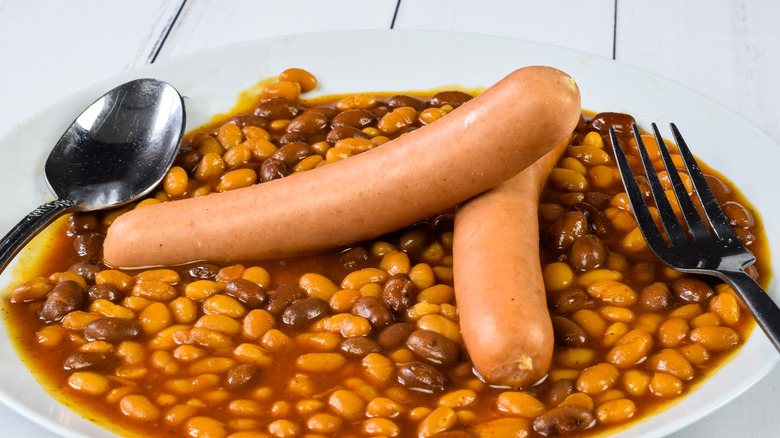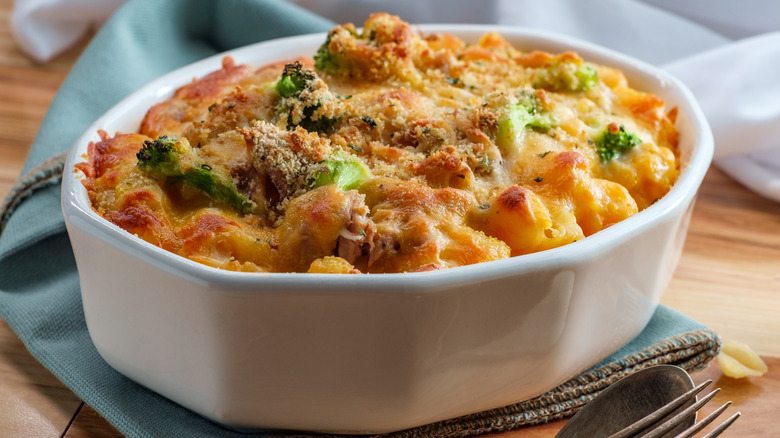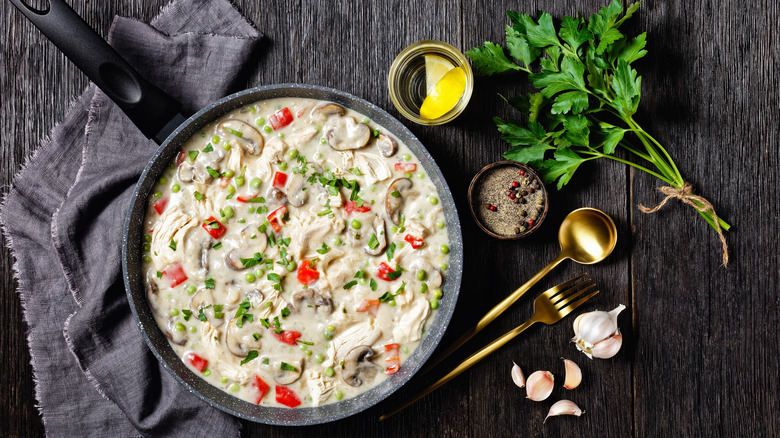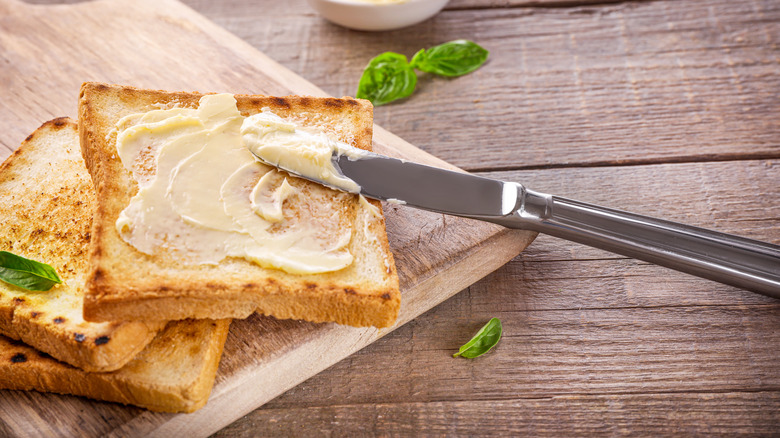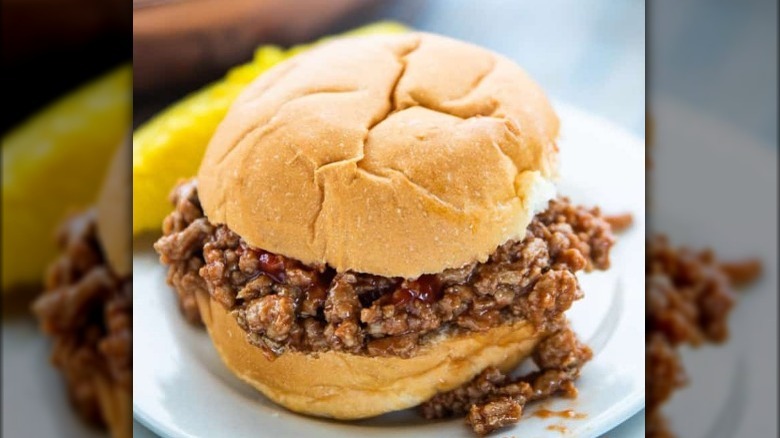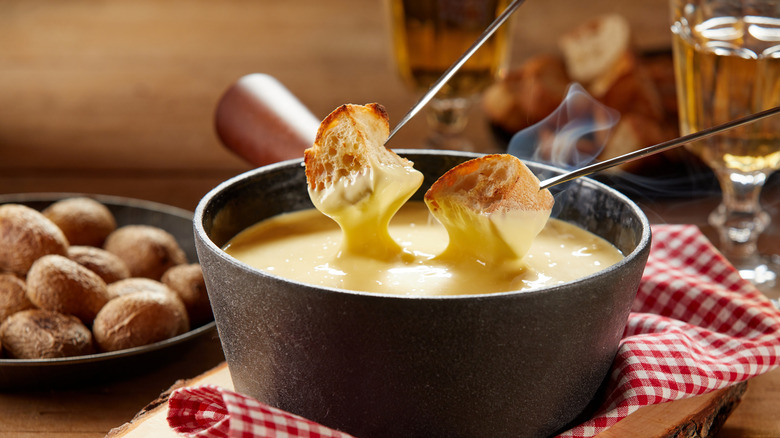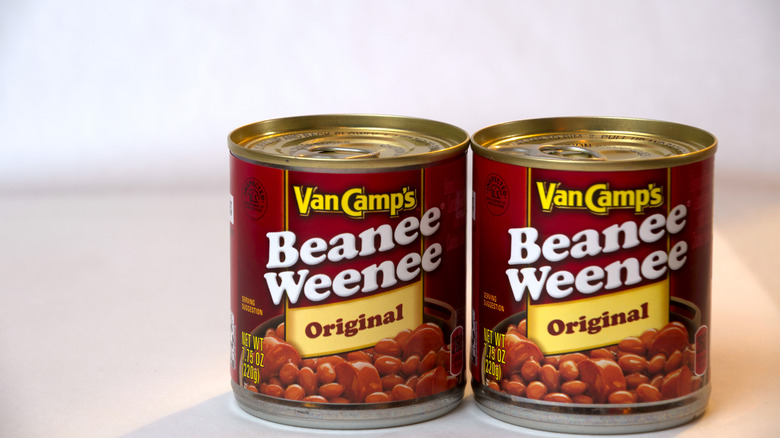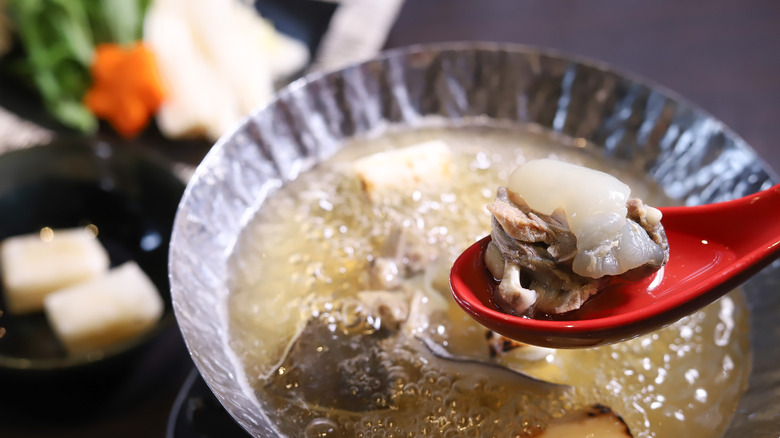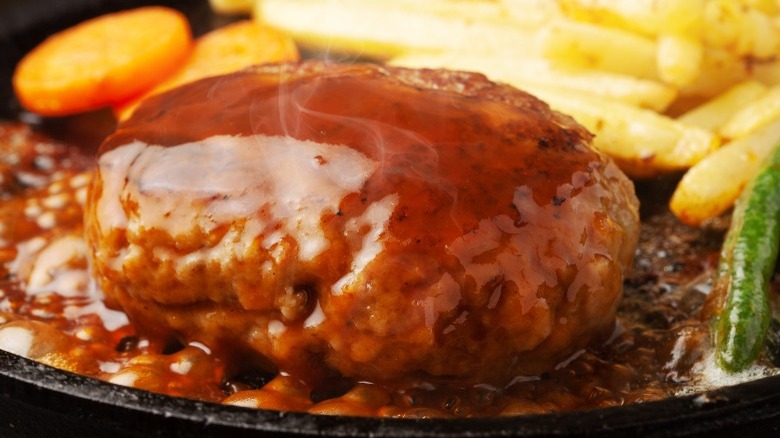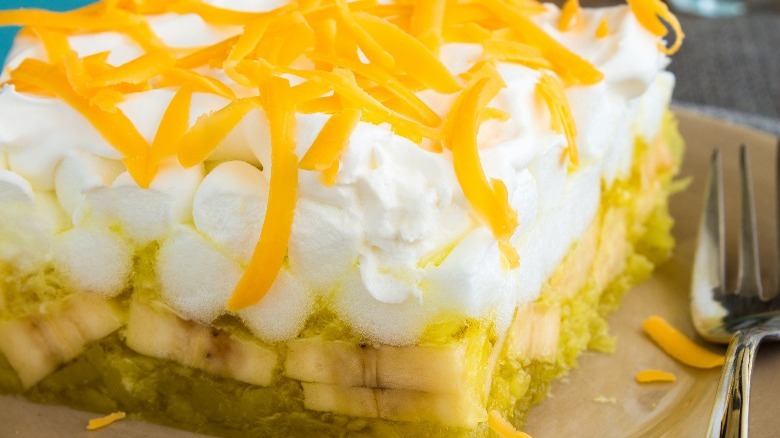Once Popular Comfort Foods No One Eats Anymore
What foods do you reach for after a long or difficult day? If you're like most Americans, your comfort food of choice is pizza (via Food Dive). Other popular answers include chocolate, ice cream, and mac and cheese. But as little as a decade ago, this likely wasn't the case. As tastes and trends change and new foods and dishes are created, so too do our choice of comfort foods.
Just as new comfort foods fall into place, old ones are cycled out. In some cases, they fall out of popularity entirely, disappearing from just about everywhere other than perhaps your grandparent's holiday tables. And when that generation stops hosting family meals, those recipes will likely fade from everywhere except the history books. Wondering what dishes and foods generations past turned to when they were in need of some comfort or a little pick-me-up? Keep reading as we explore some once-popular comfort foods that no one eats anymore.
Tuna noodle casserole
Spurred by the endless products available in newfangled supermarkets and the marketing aimed at homemakers urging them to try the latest kitchen appliances, the 1950s were a time of some truly weird food creations. From savory Jello salads to hot banana dishes, some foods of the '50s never made it out of the decade. Others, like ambrosia salad and an abundance of casseroles, haven't quite faded.
Tuna noodle casserole wasn't actually invented in the 1950s. The recipe first appeared in 1930, in a magazine published in the Pacific Northwest (via Taste). It was popular in the region well into World War II, where it gained popularity as a cheap, quick dish that was easy to make. By the 1950s, it had spread throughout the Midwest, where it became a mainstay on many dinner tables for decades to come. That is, until the late '90s and early 2000s spelled its downward trend.
While other casseroles continue to be popular comfort foods, it was the tuna casserole's primary ingredient that spelled its end. After decades of continuous growth, sales of canned tuna began to see a decline in the 1990s, thanks to growing concerns about whether or not it was healthy to eat and about its sustainability (via The Washington Post).
Chicken a la King
Many comfort foods today, like biscuits and gravy or macaroni and cheese, are pretty much ubiquitously popular across much of the U.S. But without the internet and social media to share recipes, it wasn't uncommon for comfort foods of decades past to never spread outside of a particular region.
That was the case of chicken a la king. At the turn of the 20th century, this recipe was both a comfort food and an upscale dish popular at restaurants (via Politico). The dish features diced chicken with mushrooms and peppers, served in a cream sauce and poured over toast. While the name may sound a little French, the dish was born and bred in New York City.
Between 1910 and the 1960s, the dish appeared on more than 300 menus in restaurants around the city. But by the late 1970s, it had already begun to fade (via Bklyner). You might not be able to find it on a menu anymore, but this formerly popular comfort food is surprisingly easy to make.
Milk toast
Long before a bowl of cereal and milk became breakfast table staples, another simple, comforting dish held a similar place. Milk toast traces its origins at least back to the 1800s (via New England Today Food). The dish starts with a slice of toast, spread with butter, torn into pieces, and sprinkled with cinnamon and sugar. Then, it's topped with milk that's been heated on the stove and seasoned with salt.
While it's tough to say exactly where this simple dish got its start, it is known that as late as the 1930s, recipes for milk toast were included in cookbooks, including some that offered dishes for those who were ill (via Los Angeles Times). While you may not hear about milk toast stateside much these days (most readers on New England Today reference it as food their parents or grandparents ate), a similar recipe is a popular childhood lunch item in Hong Kong (via HuffPost). Condensed milk toast features toast spread with condensed milk and butter.
Sloppy Joes
In the 1990s, sloppy Joe sandwiches were a staple of lunchroom cafeterias and potluck dinners. But the messy creation was actually invented decades ago. Some think it was created in 1930, when a cook named Joe from Sioux City, Iowa, mixed "loose meat" with tomato sauce, and served it on bread (via Blue Apron). Others claim that the iconic local hotspot, Sloppy Joe's Bar in Key West, Florida, was where it was first created. Still more think that the dish was originally a take on a classic Cuban dish, either picadillo or ropa vieja, and that it was being served in Havana, Cuba as early as 1917 (via The Takeout).
In any case, the sandwich saw a rise in popularity at the end of the 20th century. Loose meat sandwiches are still popular in Iowa (via Food & Wine). But whether or not you remember your last taste of this nostalgic childhood classic, sloppy Joes all but disappeared elsewhere at the end of the '90s (via Eat Sandwich). While it isn't clear why it disappeared around that time, it likely made its way out of cafeterias as a result of campaigns to reform school lunch programs.
Cheese fondue
Fondue first appeared in cookbooks in the 18th century in France and Belgium (via Alpenwild). But the term has its origins in Switzerland from around the same time, when it was used to refer to a meal made from bread that was often stale, dipped in cheese to make it soft and help stretch families' rations during the winter.
Fondue arrived in the U.S. in 1964, when it was featured in the Alpine-themed restaurant located in the Swiss Pavilion at the World's Fair in New York. While the restaurant would no doubt have spurred interest in this European food, fondue may have had some help growing in popularity in the United States. Following WWI, Switzerland's cheesemakers banded together to create a union and prevent competition (via Groovy History). Looking to expand their business, they launched a marketing campaign in the 1970s that usually featured actors dressed ready to ski dipping bread, meats, and more into creamy pots of melted cheese.
The campaign was successful. Home fondue pots grew in popularity, and soon fondue house parties were a growing trend. Like most trends, it faded away by the end of the decade, then appeared again in the early 2000s. While you can still dip all manner of appetizers in creamy cheese at many fondue restaurants, DIY kits have once again disappeared from most shelves.
Chipped beef on toast
Military rations today are designed with nutrition in mind. But in the last century or two, military meals have often focused more on making available rations last as long as possible. That mentality led to the creation of chipped beef on toast. White gravy was already a popular, cheap military ration by WWI, when chipped beef made its way into the recipe (via HistoryNet). The chipped beef, thin slices of smoked, salted beef, was served on a slice of toast, and then smothered in gravy, to make a hot, simple dish to fill soldiers' stomachs. The dish got a lot of names over the years, including "SOS," which could alternatively mean "Save Our Souls," "Same Old Slop," or a less family-friendly variation. Whatever they called it, soldiers across every branch began eating it from WWII on.
While it was gaining new ingredients and alternative ingredients, like adding parsley for flavor or tomato sauce to thicken the dish, chipped beef also made its way into the mainstream. Variations of the dish were a cheap meal for families during the Great Depression, and later as a popular breakfast dish at diners in Pennsylvania (via Atlas Obscura). Some national chains have even offered it on menus in the past. But while "SOS" lives on primarily as a military dish, even they've altered the recipe to make it healthier, usually trading the chipped beef for very lean ground beef or even ground turkey.
TV dinners
If you're short on time and craving a hot meal today, odds are you'll reach for your phone to order from a delivery app. But long before DoorDashers were racing through cities for tips, TV dinners were a mainstay for American families short on time and looking for simple solutions.
Frozen dinners as a concept were actually created before households had a microwave to heat them in. Clarence Birdseye, an entrepreneur from Brooklyn, developed a machine in 1925 that could freeze package fish to help it stay safe longer (via Smithsonian Magazine). A couple of decades later, frozen dinners hit the scene, but only as meals served on airlines. It would take until 1953 for 260 tons of frozen leftover Thanksgiving turkey to inspire a Swanson salesman to create partitioned aluminum trays filled with turkey and sides to freeze and sell to the public. TV dinners were born.
The frozen meal industry saw rapid growth from the mid-1950s until the turn of the century. But 2008 marked the beginning of the end of this comfort food's reign, as frozen dinners saw their first decline in almost 60 years, a trend that has continued with only brief pauses since that time (via Quartz).
Egg cream
Chicken a la King isn't the only comfort food of decades past that failed to successfully make its way out of New York. The name alone could be misleading to anyone outside of Brooklyn; while it might say "egg," you won't find any yokes or whites in an egg cream. Or any cream, for that matter. Instead, they have just three ingredients; whole milk, soda water, and chocolate syrup (via A Slice of Brooklyn Bus Tours).
This sweet comfort drink is thought by some to have been invented in the 1880s, when a Yiddish theater star by the name of Boris Thomashevsky decided to recreate a "chocolat et creme" drink that he had in Paris (via What's Cooking America). But most historians seem to agree that a Jewish candy store owner named Louis Auster made the drink. He is also rumored to have regularly sold some 3,000 of his creations in a single day. The creator of the original egg cream took the recipe for his syrup to the grave. But most Brooklyn natives swear that the only way to make one today is Fox's U-Bet Chocolate Syrup, also invented in the early 1900s.
While you can still find egg creams served in Brooklyn, they began to fade in popularity by the 1960s (though may be making a comeback), and are largely unheard of outside of New York.
Beans n' franks
Long before Army soldiers dug into piles of creamed beef on toast, they were eating baked beans. This canned food staple first emerged around the Civil War (via National Today). Sometime around the 1890s, someone had the idea to add chopped sausages to the mix, and a new comfort food was born. By 1980, beans 'n' franks were widely available pre-made in cans in the 1980s.
Frank 'n' beans was at one time such a staple of the American diet that it even had a holiday dedicated in its honor. National Beans 'N' Franks Day comes around every July 13. But both of the main ingredients in this once-popular comfort food have taken a hit in recent years. The healthiness of hot dogs has been called into question many times in the past couple of decades, including in 2021 when researchers at the University of Michigan estimated that a single hot dog can shave 36 minutes off your life (via USA Today). While baked beans remain popular, other canned foods have taken a hit in sales in recent years (via Freedonia Focus Reports).
Turtle soup
Most people wouldn't consider eating turtles in any form to be comfort food. But not so long ago, turtle soup was considered a delicacy for the upper crust. It was so popular it practically wiped out an entire turtle population. According to NPR, the diamondback terrapin was the turtle of choice for hardscrabble diners, until it shifted in the culture from a food of subsistence to a menu item for the upper-class in the mid-19th century. Even the name "terrapin" is derived from Native American words meaning "good tasting turtle." Thankfully, sherry was a key ingredient, and when Prohibition hit, turtle soup went the way of the dodo. The terrapins eventually recovered — though more than half of all turtle and tortoise species remain endangered.
As prohibited as it might have been, turtle soup made a bit of a recovery, and was found on menus from as recent as the mid-20th century. But it turns out turtle soup isn't the easiest dish to prepare, owing in part to the difficulty of removing the shell and separating usable parts from the less desirable elements. A mock turtle soup movement took hold for a while, but now, turtle soup is seen as a strange delicacy in much of the western world rather than a food modern diners turn to for comfort.
Salisbury steak
Is it steak, or is it hamburger, or is it a little of both? Salisbury steak remains one of the lasting mysteries of 20th-century comfort food trends, though it began long before that. According to Smithsonian Magazine, Dr. James Salisbury believed his chopped steak, described unappetizingly as the "muscle pulp of beef", could cure chronic diarrhea in Civil War soldiers. The article's author points out that at one time the patties of minced beef were viewed as a health food. By the time processed foods were becoming a staple of the American diet, Salisbury steak had found its way into TV dinners, an association still made by many diners today.
When TV dinners began waning in popularity in the mid-1980s, so did the Salisbury steak found in many brands' frozen offerings. Though clever culinary crafters have created their own recipes to revive the mushy meat substance, this steak-in-name-only has never regained its place in the world of comfort food. With much better fare available, turning to pulverized meat substance formed into a patty doesn't exactly scream "soothing dish." Maybe if TV dinners ever make a major comeback, Salisbury steak can find its way back to the dinner tables of the world. Here's hoping it never happens.
Jell-O salad
Who doesn't remember their grandparents (or great-grandparents) serving up Jell-O salad as a dazzling, translucent science experiment of comfort food at family dinners and holiday tables? This odd combination of Jell-O brand gelatin and just about anything you could find in the refrigerator was a comfort food standard when Jell-O itself ruled the processed food world as a sign of prosperity. There were variations for just about every taste — or lack thereof — in the world of cuisine. Onions, peppers, and vegetables levitating in lime gelatin? Yep. A tuna ring studded with green olives? You bet. Topped with shrimp and layered with carrots and spinach? Please, chef ... make it stop.
With all these creative combinations circulating around domestic dining rooms, it's not too difficult to see what might have knocked Jell-O salad off the comfort food buffet. As it turns out, fish, vegetables, and meat suspended in reconstituted connective tissue aren't all that appetizing, when you get right down to it. Once cooler culinary heads had prevailed, Jell-O jiggled back to its previous self-proclaimed status as "America's Most Famous Dessert", and Jell-O salad become nothing more than a distant memory in a torturous fever dream that got out of hand.
Watergate salad
Almost as controversial as the D.C. hotel-slash-cover-up it's named for, Watergate salad was a picnic and potluck staple in the not-so-distant past. This combination of pistachio pudding mix, marshmallows, whipped cream, and pineapple topped with chopped nuts and cherries charmed visitors to the Watergate Hotel before making its way to deli counters in grocery stores around America. But now, as NPR writer Gabe Buller aptly describes it, "The dish has largely vanished like 18 minutes of audio tape." Think of Watergate salad as ambrosia salad's hipper, vibier younger sibling, and you get a sense of why it had its moment.
The name may be partly to blame for its downfall. The Watergate Scandal made a historic American mess that reverberates through current times. More likely, the waning popularity of Jell-O pudding mix, and Jell-O salads in general, did this fluffy comfort food in. As a culinary relic of the 1970s that might be best left in the past, Watergate salad is now a kitschy reference to the days when dessert was a nightly affair and highly coordinated governmental conspiracy theories were still reserved for avid tabloid readers. Oh, how times have changed.
Election cake
Situations as stressful as elections certainly call for comfort food, and cake qualifies. But a Colonial ingredient list and texture profile that reads like a patriotic version of fruitcake isn't what any candidate orders for 21st-century dining sensibilities. Election cake had a heyday in the early years of American democracy, when molasses, warm spices, and raisins were go-to dessert ingredients and better options like cookies and cream and salted caramel had yet to rise to flavor fame.
The cake has mundane origins, starting as a sustenance dish called muster cake made for soldiers called for service by British leadership.
Once the American Revolution was over, women continued baking the cake, adding booze to celebrate the occasion of every election until the early 20th century, when it fell out of favor. Some chefs with a taste for historical treats still call up a version of the recipe when election season rolls around. But by and large, this political morsel is part and parcel of another time, and comfort food to dedicated democracy lovers no more. It's much easier to grab a Crumbl cookie on the way home from the polls to drown your sorrows or celebrate your victories.
Banana and mayo sandwiches
Aside from Dale Earnhardt Jr. sharing his taste for banana and mayo sandwiches with his Twitter followers in a 2016 tweet, this old-fashioned treat doesn't top the must-have lists for modern snackers. It originated in the South during the Great Depression as a way to turn available ingredients into semi-substantial food, with variations adding peanut butter to the mix (via Garden & Gun). Nostalgia keeps it in the secret trove of Southern treats for those who learned of its existence through family history. As far as contemporary comfort food sensibilities go, slathering mayonnaise on white bread and topping it with sliced banana has become a bit of a dining dinosaur story, but without the asteroid.
So how does Dale Earnhardt Jr. factor into this sandwich's story? The NASCAR favorite shared his recipe on his website for anyone who wants to try this forgotten — if "add bananas and mayonnaise to white bread" can be called a recipe. After writing up a piece about this comfort food antique and sharing other odd sandwich pairings, GQ took a Twitter survey to gauge public opinion. 56.6% of respondents said "Not on my life" when it came to trying a banana and mayo sandwich. That number seems a bit low.
